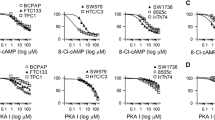Abstract
Cortistatin (CST-14, Pro-c[Cys-Lys- Asn-Phe-Phe-Trp-Lys-Thr-Phe-Ser-Ser-Cys]-Lys- NH2), a neuropeptide member of the SRIH family, binds to all 5 SRIH receptor (sst) subtypes, but also possesses a significant binding affinity to GH secretagogue receptors (GHS-R), which have been reported to mediate the antiproliferative activity of GHS on thyroid cancer cells. The effect of CST-14 on cell proliferation was studied in 3 different human thyroid carcinoma cell lines of follicular origin (N-PAP, WRO, ARO) and in one thyroid medullary carcinoma cell line (TT). CST-14 1 μM determined a significant inhibition of cell proliferation in TT, N-PAP and WRO cells and this effect was dose-dependent and more pronounced than that displayed by SRIH-14 (Ala- Gly-c[Cys-Lys-Asn-Phe-Phe-Trp-Lys-Thr-Phe-Thr- Ser-Cys]-OH) treatment. To a minor extent, CST- 14, but not SRIH-14, also temporary inhibited ARO cell proliferation. By immunofluorescence, sst2, sst3 and sst5 have been demonstrated in TT cells, whereas types 3 and 5 only were expressed in N-PAP and WRO cells, and no sst subtype was found in ARO cells. The presence of both GHS-R1a and 1b mRNA has been studied and demonstrated in the TT medullary carcinoma cell line, whereas follicular derived cell lines were already known to express GHS binding sites. Addition of EP-80874 (D-Mrp-c[D-CyspyridilalanyI3- D-Trp-Lys-Val-Cys]-Mrp-NH2), a synthetic peptide that binds to SRIH and GHS-R, completely abolished the antiproliferative effects of CST-14 or SRIH-14 on sst/GHS-R positive thyroid carcinoma cell lines (WRO, N-PAP and TT). EP-80874 was also able to antagonize the inhibitory activity of CST-14 on the growth of cells (ARO) expressing GHS-R but not sst. Taken together, these data firstly demonstrate that EP- 80874 has a mixed SRIH/CST antagonist activity and suggest that the oncostatic effect of CST-14 on thyroid cancer cells could be mediated by both sst and/or GHS-R.
Similar content being viewed by others
References
Veber D.F., Holly F.W., Nutt R.F., et al. Highly active cyclic and bicyclic somatostatin analogues of reduced ring size. Nature 1979, 280: 512–514.
de Lecea L., Ruiz-Lozano P., Danielson P.E., et al. Cloning, mRNA expression, and chromosomal mapping of mouse and human preprocortistatin. Genomics 1997, 42: 499–506.
Spier A.D., de Lecea L. Cortistatin: a member of the somatostatin neuropeptide family with distinct physiological functions. Brain Res. Rev. 2000, 33: 228–241.
Vasilaki A., Lanneau C., Dournaud P., et al. Cortistatin affects glutamate sensitivity in mouse hypothalamic neurons through activation of SSTR2 somatostatin receptor subtype. Neuroscience 1999, 88: 359–364.
Deghenghi R., Papotti M., Ghigo E., Muccioli G. Cortistatin, but not somatostatin, binds to growth hormone secretagogue receptors of human pituitary gland. J. Endocrinol. Invest. 2001, 24: RC1–3.
Zatelli M.C., Tagliati F., Taylor J.E., et al. Somatostatin receptor subtypes 2 and 5 differentially affect proliferation in vitro of the human medullary thyroid carcinoma cell line TT. J. Clin. Endocrinol. Metab. 2001, 86: 2161–2169.
Ain K.B., Taylor K.D., Tofiq S., Venkataraman G. Somatostatin receptor subtype expression in human thyroid and thyroid carcinoma cell lines. J. Clin. Endocrinol. Metab. 1997, 82: 1857–1862.
Ain K.B., Taylor K.D. Somatostatin analogs affect proliferation of human thyroid carcinoma cell lines in vitro. J. Clin. Endocrinol. Metab. 1994, 78: 1097–1102.
Cassoni P., Papotti M., Catapano F., et al. Specific binding sites for synthetic growth hormone secretagogues in nontumoral and neoplastic human thyroid tissue. J. Endocrinol. 2000, 165: 139–146.
Hoelting T., Duh Q.Y., Clark O.H., Herfarth C. Somatostatin analog octreotide inhibits the growth of differentiated thyroid cancer cells in vitro, but not in vivo. J. Clin. Endocrinol. Metab. 1996, 81: 2638–2641.
Deghenghi R., Papotti M., Ghigo E., Muccioli G., Locatelli V. Somatostatin octapeptides (lanreotide, octreotide, vapreotide, and their analogs) share the growth hormonereleasing peptide receptor in the human pituitary gland. Endocrine 2001, 14: 29–33.
Papotti M., Croce S., Bellò M., et al. Expression of somatostatin receptor types 2, 3 and 5 in biopsies and surgical specimens of human lung tumours. Correlation with preoperative octreotide scintigraphy. Virch. Arch. 2001, in press.
Korbonits M., Bustin S.A., Kojima M., et al. The expression of the growth hormone secretagogue receptor ligand ghrelin in normal and abnormal human pituitary and other neuroendocrine tumors. J. Clin. Endocrinol. Metab. 2001, 86: 881–887.
von Zastrow M. Endocytosis and down-regulation of G protein- coupled receptors. Parkinsonism Relat. Disord. 2001, 7: 265–271.
Siehler S., Seuwen K., Hoyer D. [125I]Tyr10-cortistatin14 labels all five somatostatin receptors. Naunyn Schmiedebergs Arch. Pharmacol. 1998, 357: 483–489.
Author information
Authors and Affiliations
Corresponding author
Rights and permissions
About this article
Cite this article
Cassoni, P., Muccioli, G., Marrocco, T. et al. Cortistatin-14 inhibits cell proliferation of human thyroid carcinoma cell lines of both follicular and parafollicular origin. J Endocrinol Invest 25, 362–368 (2002). https://doi.org/10.1007/BF03344019
Accepted:
Published:
Issue Date:
DOI: https://doi.org/10.1007/BF03344019




